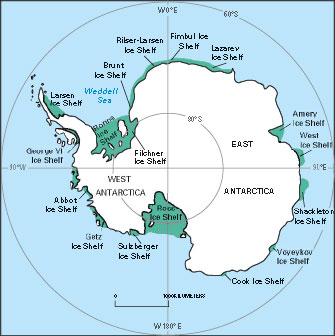
This is a map of Antarctica that I lifted from the U.S. Geological Survey website. Antarctica has the largest mass of ice in the world by far. The white areas are land mass above sea level, the greenish areas are floating ice and blue is ocean.
If someone to ask "How much water do you think is stored in the ice in Antarctica?", I reckon it'd be fair to say there is a small ocean worth there. So what would happen if you added an ocean worth of water to our oceans?
Ice reflects 90% of the suns rays and absorbs 10%. Water on the other hand reflects only 10% and absorbs 90%. So when pools of water started forming on the Larsen Ice Shelf on the Antarctic Peninsula, the bit on the top-left of the map that points to South America, the water started to heat up and melt holes in the ice, drilling tunnels into it and making it like Swiss cheese, eventually causing it to collapse under its own weight into the ocean. These ice shelves are what is holding back the ice on the land and when they melt, huge chunks of ice slide off the land and into the ocean. The video on my post "Cool Science" may give you some idea of the consequences of that.
This is a photo of the Larson B Ice Shelf on the 31st January 2002.
 You can see the the pools of water that have formed on top of the ice shelf. The shelf was a plate of ice two hundred and twenty meters thick floating on the water in the middle of the photo. Ice covered mountains can be seen on the left side of the photo.
You can see the the pools of water that have formed on top of the ice shelf. The shelf was a plate of ice two hundred and twenty meters thick floating on the water in the middle of the photo. Ice covered mountains can be seen on the left side of the photo.This photo was taken on 17th February 2002, 18 days later.
 You can see the where the ice has shattered and let thousands of icebergs drift away. The rest of the shelf is still dotted with rows of pools still absorbing heat from the suns rays and boring holes through the ice.
You can see the where the ice has shattered and let thousands of icebergs drift away. The rest of the shelf is still dotted with rows of pools still absorbing heat from the suns rays and boring holes through the ice.This photo was taken on the 23rd, of February
 The shelf degrades further, but what becomes noticeable at this point is that without the shelf to hold it up, the ice on the mountains is shifting and sliding into the ocean.
The shelf degrades further, but what becomes noticeable at this point is that without the shelf to hold it up, the ice on the mountains is shifting and sliding into the ocean.This photo was taken on 5th of March, 2002.
 In less than five weeks, three thousand two hundred and fify square kilometers of ice has separated itself from the Antarctic continent, not only floating ice from the shelf, but the ice on the land which adds vast amounts of water to our oceans.
In less than five weeks, three thousand two hundred and fify square kilometers of ice has separated itself from the Antarctic continent, not only floating ice from the shelf, but the ice on the land which adds vast amounts of water to our oceans.This photo was taken on the 7th of March, 2002.
 I got these photos from the NASA Earth Observatory.
I got these photos from the NASA Earth Observatory.This is not an isolated incident. The great glaciers of the world are melting and quite a number have completely gone. The ice in Greenland is cracking and threatening to slide into the North Atlantic. The ice at the North Pole is melting. Some scientist say that it could be gone in only ten years. Have a look around on the net. The scientist all agree that we could be looking at a world that is very hard for people to live on possibly in as little as ten years and if we keep going the way we are now, vast areas of Earth will certainly be unlivable in fifty years.
Comments are welcome.
No comments:
Post a Comment